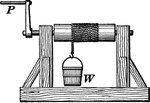Wheel and Axle
This science ClipArt gallery offers 36 illustrations of the wheel and axle. Wheels and axles are composed of a wheel affixed to the end of an axle, and is used to convert rotational into linear motion, most often for the purpose of lifting.
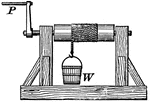
Bucket and Crank
Sometimes it is not necessary for an entire wheel to be used. A projection of any kind that can cause…
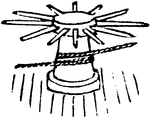
Capstan
"The capstan is a familiar example of this form of wheel and axle. It is used by sailors for warping…
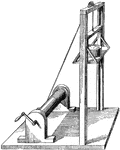
Brick and Mortar Elevator
An illustration of a type of elevator composed of a small pulley used in this case to lift brick and…
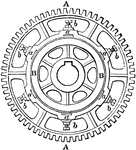
Friction Wheel
"In machinery, a form of slip-coupling applied in cases where the variations of load are sudden and…
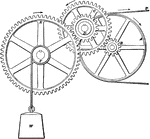
Train
"A combination of wheels and axles, as shown, is called a train. The wheel in a train to which motion…
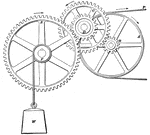
Gear Train
A combination of wheels and axles, called a train. The wheel that is moving with a belt is called a…

Simple Machine
A wheel and axle has two cylinders of different diameters that are connected so that they turn about…

Wheel Position
The manner in which the wheels of a railway car orient themselves around a curve. The outer and inner…

Rope Machine
"The large wheel a, is supposed to stand over the well, and b, a smaller wheel, is fixed in the water.…
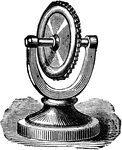
Savart wheel
"The Savart wheel consists of a heavy metal toothed wheel that may be put in rapid revolution by pulling…

Spinning Jenny
"This machine carried a number of spindles turned by cords or belts from the same wheel, and operated…
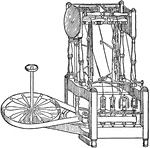
Arkwright's Spinning Machine
A spinning machine which produced a stronger thread than the spinning jenny.

Spinning Mule
A spinning machine invented by Samuel Crompton. It spins textile fibers into yarn by an intermittent…

A Spinning Wheel
"A band or cord (E) connected the large wheel with the small wheel (D). Another cord (F) connected the…
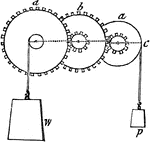
System of Wheels
"System of Wheels.—As the wheel and axle is only a modification of the simple lever, so a system…
!["[This illustration] shows a third form of the wheel and axle. Here the axle A is vertical, instead of horizontal. A bar inserted in its head, at the extremity of which the hand is applied, takes the place of the wheel." —Quackenbos 1859](https://etc.usf.edu/clipart/36300/36346/vert_whax_36346_mth.gif)
Vertical Wheel and Axle
"[This illustration] shows a third form of the wheel and axle. Here the axle A is vertical, instead…
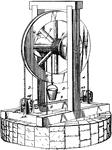
Water Elevating Device
A water well is an excavation or structure created in the ground by digging, driving, boring or drilling…
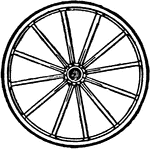
Wheel
A wheel is a circular device that is capable of rotating on its axis, facilitating movement or transportation.
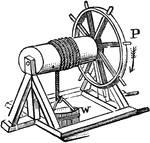
Wheel and axle
"The wheel and axle consists of a wheel united to a cylinder in such a way that they may turn together…

Wheel and Axle
"The wheel and axle consists of two cylinders of different diameters, rigidly connected, so that they…
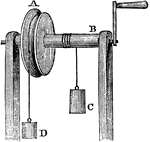
Wheel and Axle
"It consists of two wheels, one of which is larger than the other, but the small one passes through…
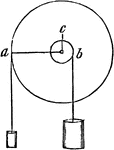
Wheel and Axle
"This figure represents the machine endwise, so as to show in what manner the lever operates. The two…

Wheel and Axle
"To change the direction, it is only necessary that the rope by which the weight is to be raised, should…
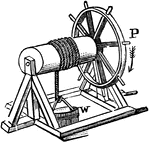
Wheel and Axle with Rope and Bucket
"The wheel and axle consists of a wheel united to a cylinder in such a way that they may turn together…
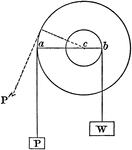
Wheel and Axle
"Considered as a lever, the fulcrum is at the common axis, while the arms of the lever are the radii…

Wheel and Axle with Rope and Bucket
"...the mechanical advantage of this machine (wheel and axle) equal the ratio between the radii, diameters,…
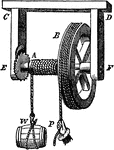
Wheel and Axle
"The wheel and axle is simply a revolving lever of the first kind. One application of the lever can…
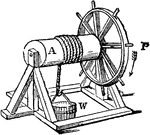
Wheel and Axle with Spokes
"Instead of having a rope attached to it, the wheel is often provided with projecting pins, as shown,…
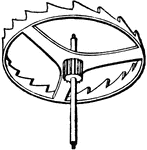
Crown Wheel
A wheel having cogs or teeth set at right angles with its plane. Commonly used in watches.

Old-Fashioned Wheel
An image of an old-fashioned wheel. It was most likely used on a steam coach or carriage in the nineteenth…
!["A still more common form, much used in drawing water from wells and loaded buckets from mines, is shown [here]. Instead of a wheel, we have here a winch, or handle, attached to the axle." —Quackenbos 1859](https://etc.usf.edu/clipart/36300/36345/winch_36345_mth.gif)
Winch
"A still more common form, much used in drawing water from wells and loaded buckets from mines, is shown…
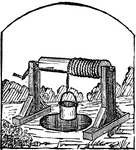
Windlass
A cylinder or roller for raising weights, turned by a crank or lever, with a rope or chain attached…
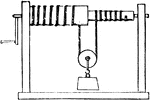
Windlass
"Windlass.—The common windlass for drawing water is another modification of the wheel and axle.…


